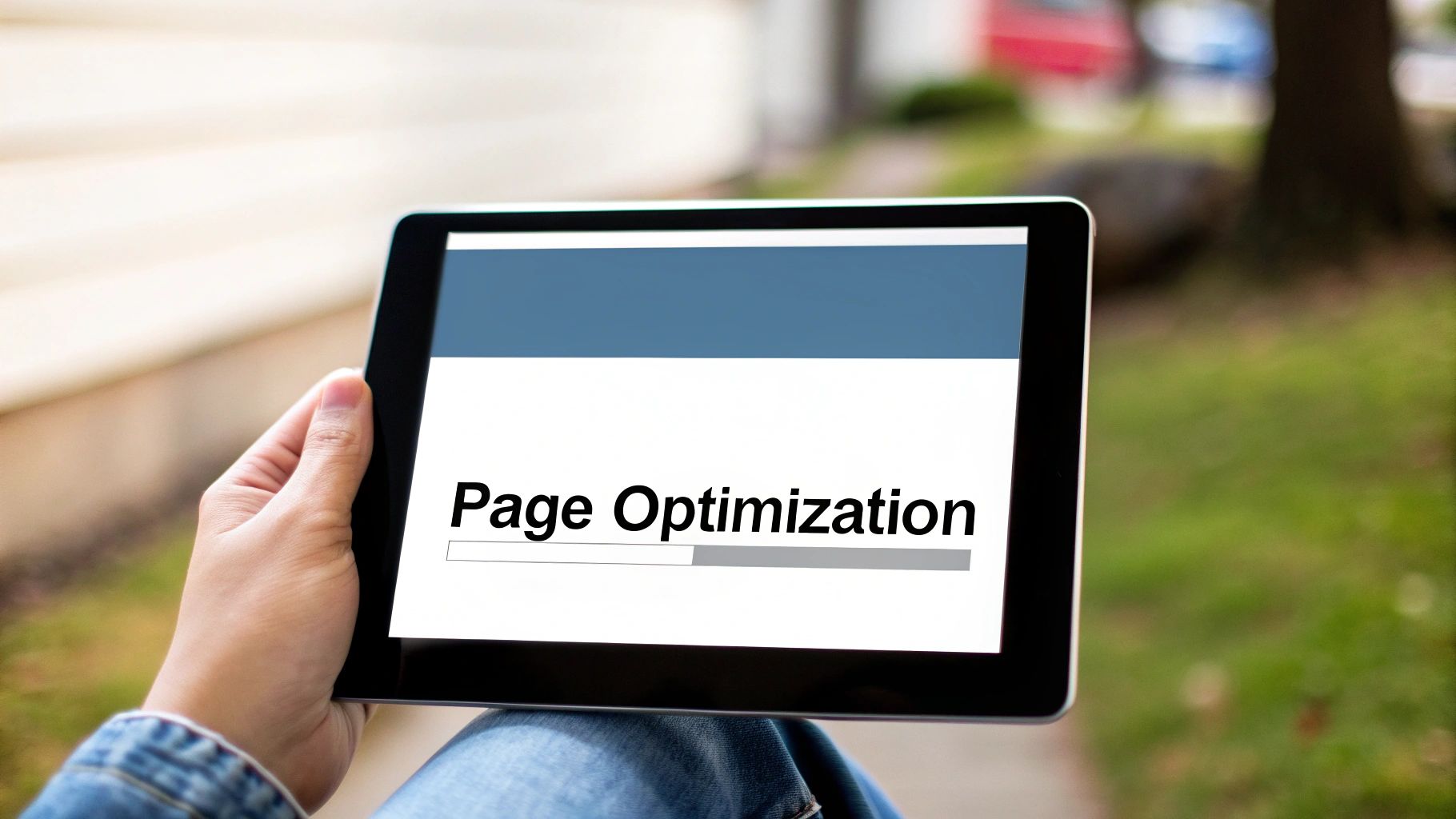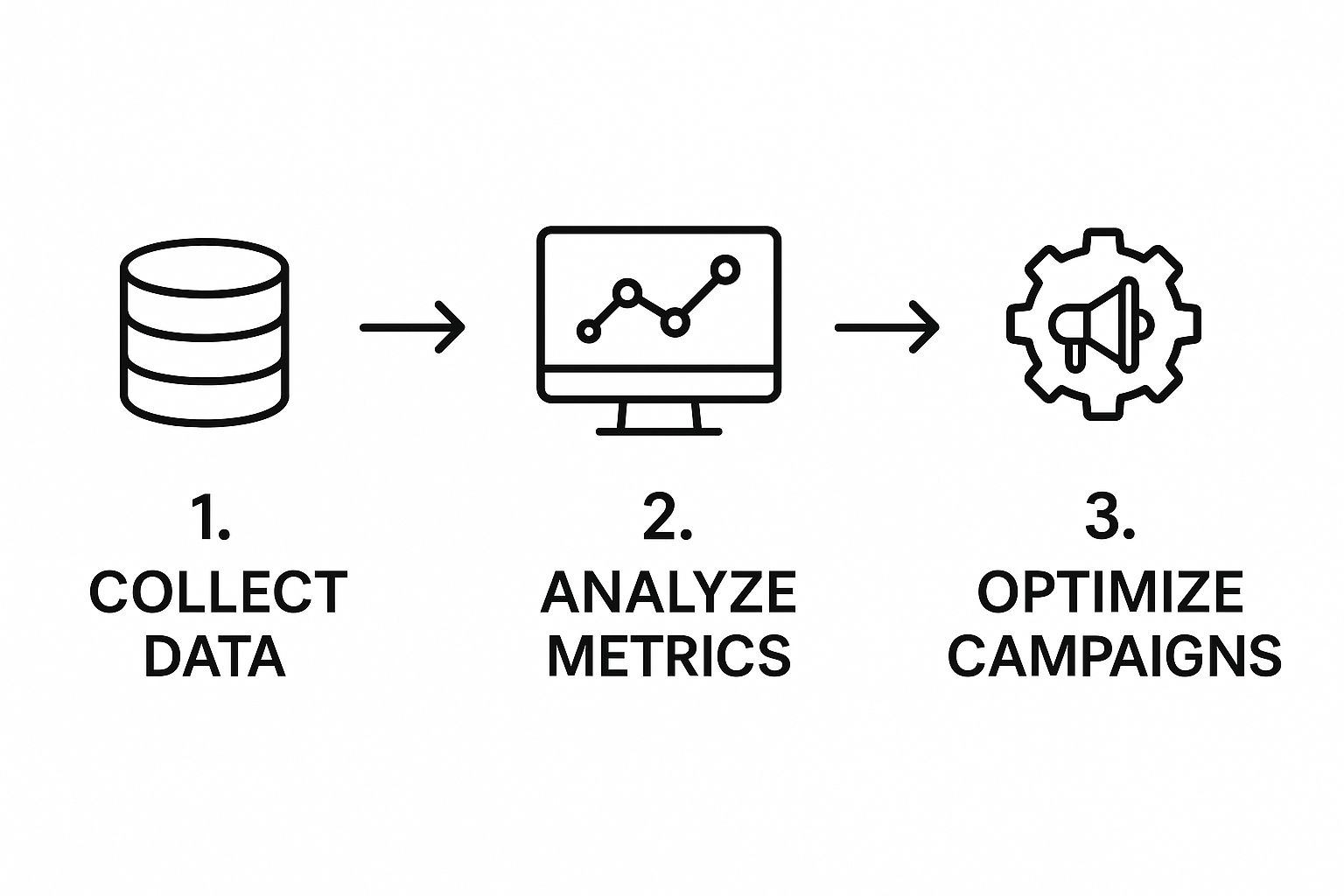Inbound marketing is a fundamentally different way to think about generating leads. Instead of shouting at potential customers with ads they didn’t ask for, you’re pulling them in with genuinely helpful content and experiences. It’s about becoming a trusted resource, turning anonymous website visitors into genuinely interested prospects who actually want to hear from you. This approach doesn’t just get you leads; it builds relationships and delivers higher-quality prospects from the get-go.
Building Your Foundation for Modern Lead Generation

Let’s be honest, the way people buy has completely changed. Today’s buyers hold all the cards. They’re armed with endless information online and have developed a powerful filter for traditional sales pitches. This is exactly why inbound marketing isn’t just a buzzword—it’s become the engine for sustainable business growth. It completely flips the old script by focusing on earning attention, not buying it.
Instead of blasting messages out to a massive, often uninterested audience, a solid inbound strategy pulls in highly specific, qualified prospects. You make this happen by creating content that speaks directly to their questions, pain points, and ambitions. That content could be a deep-dive blog post, an insightful webinar, a helpful checklist, or anything in between.
The Inbound Advantage
The real magic of inbound is that it establishes trust long before a sales conversation ever takes place. When a potential customer stumbles upon your content and finds it useful, they start seeing your brand as a credible authority in your industry. That initial trust is the bedrock of any strong, long-term customer relationship.
The benefits become pretty clear, pretty quickly:
- Higher Quality Leads: You’re attracting people who are actively researching solutions. This means they’re far more engaged and much closer to making a purchase decision.
- Stronger Brand Authority: When you consistently provide value, you position your company as the go-to expert. People remember that.
- Long-Term Asset Creation: Think about it. A paid ad stops working the second you stop paying. A high-ranking blog post, on the other hand, can continue to generate leads for years to come.
This shift isn’t just some passing trend; it’s a proven, more effective way to do marketing. You’re not just finding customers—you’re building a system where the right customers find you.
Inbound vs Outbound Marketing at a Glance
To really see the difference, it helps to put the two approaches side-by-side. Outbound is the traditional “push” method, while inbound is all about the “pull.”
| Attribute | Inbound Marketing | Outbound Marketing |
|---|---|---|
| Approach | Pulls customers in with valuable content (blogs, SEO, social) | Pushes messages out to a broad audience (cold calls, ads) |
| Communication | Two-way conversation; seeks to educate and engage | One-way communication; focused on broadcasting a sales message |
| Audience | Targeted individuals actively seeking solutions | Broad, often untargeted audience |
| Cost Per Lead | Typically lower, as content is a long-term asset | Generally higher, requiring continuous ad spend |
| Customer Focus | Centers on customer needs and pain points | Centers on the product or service’s features |
The table makes it clear: inbound marketing is a more strategic, customer-centric, and cost-effective method for building a sustainable pipeline of quality leads.
The Numbers Don’t Lie
The data consistently shows that inbound marketing runs circles around old-school outbound methods. Inbound tactics generate 54% more leads than traditional outbound marketing, and they do it far more efficiently.
Even more impressive? Inbound marketing costs 62% less per lead compared to outbound. For any business watching its budget, that’s a game-changer.
Of course, none of this works if you don’t know who you’re talking to. The entire strategy rests on a deep understanding of your ideal customer. Before you write a single word or plan any campaign, you need a crystal-clear picture of who you’re trying to reach. If you’re not sure where to start, our guide on how to create buyer personas breaks down the entire process, step by step.
Creating Content That Actually Attracts Your Ideal Customer
Let’s be honest, inbound marketing is powered by one thing: content that actually solves a real-world problem. This isn’t about just hitting a publishing quota with generic blog posts. It’s about crafting genuinely useful resources that speak directly to the headaches and questions of your ideal customers, making you the obvious expert they turn to.
The real work starts way before you even think about writing. You need to get inside the heads of your buyer personas. What’s keeping them awake at night? What are the biggest hurdles they face at work? More importantly, what are they typing into Google at this very moment? The answers to these questions are the bedrock of content that connects and, ultimately, converts.
Picture this: a SaaS company wants to sell to sales managers across the Nordics. Through some digging, they discover a common struggle is getting Q4 forecasts right. Instead of a generic “Top 10 Sales Tips” article, they create something incredibly specific—a data-backed whitepaper called “The Nordic Sales Leader’s Playbook for Nailing Q4 Forecasting.” See the difference? That title alone screams relevance and value.
Brainstorming and Validating Your Content Ideas
Once you have a solid grasp of your audience’s challenges, the ideas will start flowing. But don’t just think in terms of blog posts. A great content plan uses a mix of formats, each tailored to a different point in their buying journey.
- For Awareness (Top of Funnel): This is where you answer broad questions. Think educational blog posts, shareable infographics, and quick, helpful videos.
- For Consideration (Middle of Funnel): Here, you dive deeper. This is the place for in-depth guides, whitepapers, compelling case studies, and expert webinars that explore solutions.
- For Decision (Bottom of Funnel): Time to get specific. Offer up product demos, free trials, and detailed comparison sheets that make the final choice easy.
Before you pour a ton of resources into creating that masterpiece, take a moment to validate it. A quick keyword search on a tool like Ahrefs or Semrush will tell you if people are actually searching for your topic. You could even run a quick poll on LinkedIn or ask your email subscribers. This simple gut-check saves a lot of wasted effort.
Your aim isn’t just to add to the noise. It’s to create the single best resource on a specific topic for your specific audience. When someone lands on your guide, they should feel like they’ve found the final answer.
Crafting Content That Converts Visitors
Putting the content out there is just step one. You have to build it in a way that nudges the reader toward the next logical step. Every single piece of content needs a clear purpose and a call-to-action (CTA).
That blog post on sales forecasting? It should have a clear CTA inviting readers to download the more detailed whitepaper. A case study showing off a client’s amazing results should end with a button to “Request a Personalized Demo.” You’re not being pushy; you’re guiding them on a journey, building trust as you go.
In the end, your content has to do more than just pull in traffic; it needs to create genuine demand for what you sell. By zeroing in on value and aligning every topic with your audience’s needs, you build a powerful engine for inbound leads. To see how this fits into a bigger picture, take a look at these powerful demand generation strategies that are built on this exact content-first approach. This is how you turn a static website into a machine that consistently brings in new business.
Optimizing Your Digital Channels to Capture Leads

It doesn’t matter how brilliant your content is if your ideal customers never find it. The next piece of the puzzle is building clear pathways that guide prospects straight to your best resources. This is all about mastering the digital channels where your audience actually lives and breathes.
Think of it as making yourself impossible to miss. You need a solid approach that pairs the long-term authority of search engine optimization (SEO) with the here-and-now engagement of social media. When these two work in tandem, they create a steady, reliable stream of the right kind of traffic.
Mastering Search Intent with Keyword Research
Good SEO always starts with getting inside your audience’s head. What are they really searching for? This isn’t a guessing game; it’s about digging into keyword research to uncover high-intent queries. These are the exact phrases people type when they’re actively hunting for a solution, not just casually browsing.
For instance, someone at the very beginning of their journey might Google “what is sales forecasting.” That’s informational. But a far more qualified lead, someone closer to making a decision, will search for something like “best sales forecasting software for SaaS.” Targeting that second query is how you attract people who are ready to take action.
The real goal of keyword research isn’t just finding popular terms. It’s about finding the relevant terms that signal someone has a problem you can solve. That small shift in perspective changes everything.
On-Page SEO and Building Authority
Once you’ve locked in your keywords, you need to make sure search engines can connect the dots between those terms and your content. This is where on-page SEO becomes your best friend. It involves making a few crucial, but straightforward, tweaks to your blog posts and landing pages.
Here are the key on-page elements to nail down:
- Title Tags: Make sure your main keyword appears naturally in the page title. It’s the first thing Google sees.
- Meta Descriptions: Write a snappy, compelling summary (around 155 characters) that includes your keyword and makes people want to click.
- Header Tags (H1, H2, H3): Use headings to structure your content logically. Weave your target keywords and related phrases into them.
- URL Slugs: Keep your URLs short and descriptive. A clean URL like
/sales-forecasting-softwareis much better than a jumble of numbers and letters.
But your work doesn’t stop there. Earning backlinks from other credible websites is a powerful signal to Google that your content is authoritative. You can do this by writing guest posts for respected industry blogs or publishing original research that other people will want to link to. Every quality backlink is like a vote of confidence, and it will steadily push your rankings higher.
Distributing Content on Social Platforms
SEO is a marathon, not a sprint. Social media, on the other hand, gives you an immediate way to put your content in front of the right people. For any B2B company trying to reach Nordic decision-makers, LinkedIn is absolutely essential for sharing content and sparking real conversations.
Don’t just drop a link and walk away. Pull out a key statistic from your article, pose a challenging question, or tag a few industry leaders to get their take. This approach turns a static blog post into a dynamic conversation starter, which is what truly drives traffic and engagement.
This focus on distribution and optimization simply isn’t optional. Lead generation is a top priority for half of all marketers, and a massive 76% count on content marketing to get it done. With 97% of people now ignoring cold calls, these inbound strategies for attracting genuinely interested prospects are more vital than ever. You can explore more of these fascinating lead generation statistics at ExplodingTopics.com.
Turning Anonymous Visitors into Qualified Leads

All the traffic in the world is just a vanity metric if it doesn’t lead to actual business. The real magic happens when you turn those anonymous clicks into known contacts, and that starts with a value exchange.
You need to offer something so useful—a lead magnet—that visitors are more than willing to share their contact information for it. This isn’t about a hard sell. It’s about providing a solution to a problem they’re actively trying to solve. The secret is matching your offer to where they are in their buying journey.
- Awareness Stage: Someone just realizing they have a problem isn’t looking for a demo. They want information. Think checklists, insightful eBooks, or a detailed whitepaper.
- Consideration Stage: Now they’re weighing their options. A webinar comparing solutions, a compelling case study, or a practical template can guide their decision-making process.
- Decision Stage: When they’re ready to pull the trigger, the offer needs to be direct. This is the time for a free consultation, a product trial, or a custom quote.
Designing High-Converting Landing Pages
Every great lead magnet deserves its own stage: the landing page. This isn’t just another page on your website. It’s a specialized conversion tool with a single, focused objective—persuading the visitor to fill out that form.
A killer landing page is clean, persuasive, and, most importantly, free of distractions. Strip away the main navigation, the footer, and any other links that might tempt them to click away. The headline has to be powerful and benefit-driven, echoing the promise that got them there in the first place. Use bullet points to lay out exactly what they’re getting; people scan, so make it easy for them.
The best landing pages don’t feel like a gate. They feel like the next logical step in a helpful conversation you’ve already started with your content.
Building Frictionless Forms and Persuasive CTAs
I’ve seen so many potential leads vanish the second they see a long, complicated form. Keep it short. Seriously. Ask only for what you absolutely need right now. For a simple eBook, a name and email is usually plenty.
You can always gather more information later on. In fact, that’s where B2B data enrichment services come in handy; they can fill in the blanks on company details without you ever having to ask the lead for them.
Finally, give your call-to-action (CTA) button some life. “Submit” is boring and uninspiring. Instead, use active language that reinforces the value they’re about to receive. Try phrases like “Get My Free Guide,” “Download the Template,” or “Watch the Webinar Now.” It makes a huge difference. Surround that form with trust signals—a few client logos or a short testimonial can be just the nudge someone needs to convert.
How to Automate and Scale Your Lead Generation Engine
Real, sustainable inbound lead generation isn’t about grinding harder—it’s about working smarter. Once you’ve got content pulling in visitors and lead magnets doing their job, the real magic begins: building a system that can nurture those relationships at scale. This is where technology becomes your best friend, transforming tedious manual follow-ups into a smooth, automated engine that runs 24/7.
The whole point is to create personalized journeys for your leads without having to hand-hold every single one. Marketing automation platforms like HubSpot or Marketo are built for exactly this. You can set up email workflows that trigger based on what a lead actually does. For example, if someone downloads your whitepaper on financial forecasting, they could automatically get a series of emails over the next few weeks, each sharing a related tip, a relevant case study, or an invite to a webinar on the topic.
Segmenting Your Audience for Maximum Impact
A powerful automation system is useless if you don’t know who you’re talking to. This is where a Customer Relationship Management (CRM) system becomes the non-negotiable hub of your entire operation. Think of it as your central brain, tracking every single interaction a lead has with your brand—from the first blog post they read to the emails they open and the links they click.
This data is gold. It lets you slice and dice your audience with incredible precision. You can create distinct lists based on things like:
- Demographics: Industry, company size, or a specific job title like “Head of Operations.”
- Behavior: Which specific pages they’ve visited (like your pricing page), or which lead magnets they’ve downloaded.
- Engagement: How often they open your emails or if they’ve stopped clicking on your links lately.
This level of organization is what separates a generic email blast from a message that feels genuinely personal and helpful. You’re sending the right message to the right person, right when it matters most.
A well-implemented system doesn’t just manage leads; it builds relationships. By delivering consistent value automatically, you stay top-of-mind and guide prospects through their decision-making process without overwhelming them.
Prioritizing Your Best Leads with Scoring
Let’s be honest: not all leads are created equal. Some are just kicking the tires, while others are primed for a sales conversation. Lead scoring is how you automatically separate the hot from the cold, assigning points to leads based on their profile and the actions they take. This simple system ensures your sales team focuses its energy where it will have the biggest impact.
Here’s a quick look at how you might set it up:
- +10 points for visiting your pricing page (a strong buying signal).
- +5 points for being a manager-level contact at a company in your target industry.
- -5 points if their email address is from a free provider like Gmail (often lower quality).
Once a lead hits a certain score—say, 50 points—they can be automatically flagged as a “sales-qualified lead” (SQL) and routed straight to your sales team. This data-driven approach means your reps spend their valuable time talking to the most engaged, promising prospects.
To get all this working, you need the right tools in your corner. Building a solid inbound tech stack doesn’t have to be complicated, but each piece plays a crucial role.
Essential Tools for Your Inbound Tech Stack
| Tool Category | Purpose | Example Tools |
|---|---|---|
| CRM System | The central database for all customer and lead information, tracking every interaction. | HubSpot, Salesforce, Zoho |
| Marketing Automation | For creating email workflows, nurturing leads, and segmenting audiences automatically. | Marketo, Pardot, ActiveCampaign |
| Analytics & SEO | To track website traffic, understand user behavior, and optimize content for search. | Google Analytics, Semrush, Ahrefs |
| Content Management (CMS) | The platform for publishing and managing your blog, landing pages, and website. | WordPress, Webflow, Ghost |
| Landing Page Builder | For creating high-converting landing pages specifically for your lead magnets. | Leadpages, Instapage, Unbounce |
Having these technologies integrated allows you to create a seamless flow of data, from the first website visit to the final sale, making the whole process more efficient and effective.
This systematic process—collecting data, analyzing what’s working, and constantly tweaking your campaigns—is the key to scaling your efforts without burning out.

The numbers back this up. Research shows that 76% of companies already use automation for their inbound marketing. What’s more, businesses with an integrated CRM are 128% more likely to have an effective strategy. In fact, simply automating lead management can boost revenue by 10% in just six to nine months. You can discover more about these inbound marketing findings on Sender.net.
Got Questions? We’ve Got Answers
Even the best-laid plans run into real-world questions once you start putting them into practice. Getting ahead of these common hurdles is the key to building momentum with your inbound strategy. Let’s dig into some of the questions I hear most often from teams just getting started.
It’s one of the first things everyone wants to know: when do we see the leads? It’s a fair question, but it’s crucial to set the right expectations from day one.
How Long Until We See Results from Inbound Marketing?
Honestly, you have to play the long game here. Inbound marketing isn’t a faucet you can just turn on for instant leads; it’s more like planting a garden that yields a harvest for years to come.
You might see a few quick wins from a social media post or an email blast, but for that steady, predictable flow of organic leads? You’re looking at a 6 to 12-month runway. That’s the time it takes for consistent, high-quality content and smart SEO work to really take root. The upside is massive, though. Unlike paid ads that disappear the second you stop funding them, the articles and resources you create become assets that keep working for you, compounding their value over time.
What Metrics Actually Matter?
It’s easy to get bogged down in data. To keep your sanity and focus on what’s actually driving growth, you need to zero in on the metrics that directly connect to revenue.
Here are the vital signs I always keep on my dashboard:
- Website Traffic: Specifically, how much is coming from organic search? This is your proof that the SEO grind is paying off.
- Visitor-to-Lead Conversion Rate: Are your lead magnets and landing pages actually compelling people to hand over their contact info? This number tells you.
- Cost Per Lead (CPL): This is your efficiency score. It helps you understand how much you’re spending to acquire a lead and lets you compare inbound’s ROI against other channels.
- Lead-to-Customer Conversion Rate: This is the big one. It tells you if you’re attracting the right kind of leads—the ones who actually open their wallets.
Tracking these core numbers gives you a no-fluff, actionable view of your inbound engine’s health. You’ll know exactly what’s working and where you need to make adjustments.
Is Inbound Marketing a Viable Option for Small Businesses?
Yes, one hundred percent. In fact, for small businesses, a smart inbound strategy often beats traditional advertising hands down in terms of cost-effectiveness. The trick is not to try and boil the ocean.
Don’t go head-to-head with the industry giants. Instead, carve out a specific niche and become the absolute authority there. Pour your energy into creating incredibly helpful, problem-solving content for that narrow audience. Master your on-page SEO for those specific long-tail keywords, and get surgical with your distribution on free channels like LinkedIn. When you focus your efforts this way, even a modest budget can deliver a serious return.
How Does a Sales Database Plug into an Inbound Strategy?
This is where things get really powerful. Think of a targeted sales database not as a separate tool, but as a turbocharger for your inbound engine. It creates a killer hybrid approach.
Inbound is fantastic for attracting people who are actively looking for a solution. But what about all the companies that are a perfect fit for you but just haven’t stumbled across your content yet? That’s where the database comes in.
You can proactively identify companies that fit your ideal customer profile to a T. Then, instead of a cold pitch, you reach out with the valuable content you’ve already created—an invitation to a webinar, a link to a new industry report, or an insightful guide. It’s the perfect blend of inbound principles and account-based marketing, letting you engage your dream clients by leading with value.
Ready to make your outreach more strategic? The Nordic Lead Database gives you access to the most comprehensive list of decision-makers and companies in the Nordic region. It’s all about helping your team connect with the right people at the right time. Find your next customer today.
